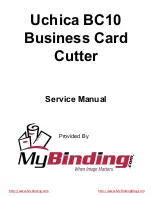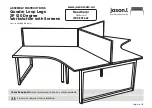
Steering Circuit (5410/5410-D/5510/5510-D/5610)
A 4-section gear pump is coupled to the piston (traction) pump. Gear pump
section P3 supplies hydraulic flow to the steering control valve and for the
traction charge circuit. The gear pump takes its suction from the hydraulic
reservoir. Steering circuit pressure is limited to 6,900 kPa (1,000 psi) by a relief
valve (R10) located in the steering control.
With the steering wheel in the neutral position and the engine running, flow enters
the steering control valve at the P port and goes through the steering control
spool valve, by-passing the rotary meter (V1) and steering cylinder. Flow leaves
the control valve through the T port to the oil filter and traction charge circuit.
Left Turn
When a left turn is made with the engine running, the turning of the steering
wheel positions the steering control spool valve so that flow is directed through
the bottom of the spool. Flow entering the steering control valve at the P port
goes through the spool and is routed to 2 places. First, most of the flow through
the valve is bypassed out the T port back to the oil filter and traction charge
circuit. Second, the remainder of the flow is drawn through the rotary meter (V1)
and out the L port. Pressure contracts the steering cylinder piston for a left turn.
The rotary meter ensures that the fluid flow to the steering cylinder is proportional
to the amount of turning on the steering wheel. Fluid leaving the steering cylinder
flows back through the steering control spool valve and then out of the steering
control valve through the T port and to the oil filter and traction charge circuit.
The steering control valve returns to the neutral position when turning is
completed.
Right Turn
When a right turn is made with the engine running, the turning of the steering
wheel positions the steering control spool valve so that flow is directed through
the top of the spool. Flow entering the steering control valve at the P port goes
through the spool and is routed to 2 places. As in a left turn, most of the flow
through the valve is by-passed out the T port back to the oil filter and traction
charge circuit. Also like a left turn, the remainder of the flow is drawn through
rotary meter (V1) but goes out port R. Pressure extends the steering cylinder
piston for a right turn. The rotary meter ensures that the fluid flow to the steering
cylinder is proportional to the amount of the turning on the steering wheel. Fluid
leaving the steering cylinder flows back through the steering control spool valve
then through the T port and to the oil filter and traction charge circuit.
The steering control valve returns to the neutral position when turning is
completed.
Hydraulic System: Hydraulic Flow Diagrams
(5410/5410-D/5510/5510-D/5610)
Page 6–30
Reelmaster
®
5410/5510/5610 Series
15216SL Rev C
Summary of Contents for Reelmaster 5510 Series
Page 4: ...NOTES NOTES Page 4 Reelmaster 5410 5510 5610 Series 15216SL Rev C...
Page 10: ...Preface Page 10 Reelmaster 5410 5510 5610 Series 15216SL Rev C...
Page 18: ...Safety Safety and Instructional Decals Page 1 8 Reelmaster 5410 5510 5610 Series 15216SL Rev C...
Page 356: ...Hydraulic System Service and Repairs Page 6 238 Reelmaster 5410 5510 5610 Series 15216SL Rev C...
Page 594: ...Cutting Unit Service and Repairs Page 9 64 Reelmaster 5410 5510 5610 Series 15216SL Rev C...
Page 662: ......















































